Yamagata and more
- Sort by
- Popularity
- Name
-
Hasami ware Hasami yaki
- Ceramic
- Nagasaki
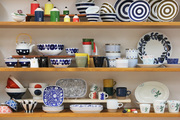
Hasami ware (called Hasami yaki in Japanese) is a form of porcelain produced in Hasami in Nagasaki prefecture. It is a traditional handicraft that was first produced in the latter part of the Sengoku period (1467-1603) and remains popular today as…
View more
-
Yuki tsumugi silk Yuki tsumugi
- Woven textiles
- Ibaraki

Yuki tsumugi silk is produced principally in the reaches of the Kinugawa River that straddles the Ibaraki and Tochigi prefectures. The Japanese name Yuki tsumugi comes from the name of a feudal lord during the Kamakura period (1185-1333), Yuki. Al…
View more
-
Kasama ware Kasama yaki
- Ceramic
- Ibaraki

Kasama ware (called Kasami yaki in Japanese) is a form of porcelain produced in the area around the city of Kasama in Ibaraki prefecture. This porcelain has long been considered a traditional souvenir of visiting Kasama Inari shrine (one of Japan&…
View more
-
Iga ware Iga yaki
- Ceramic
- Mie
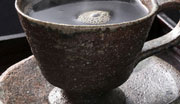
Iga ware (called iga yaki in Japanese) is a form of porcelain produced in the area around the city of Iga, Mie prefecture. The main production areas of this craft are the sites of Makiyama and Marubashira in the Ayama district of Iga and the excel…
View more
-
Echizen traditional Japanese paper Echizen washi
- Traditional Japanese paper
- Fukui

Echizen washi is a Japanese traditional paper made in the basin of the Okafuto river of the Echizen region, Fukui prefecture. Washi is made mostly from the inner bark fibers of plants such as paper mulberry, paperbush, and ganpi. Echizen washi fea…
View more
-
Mikawachi ware Mikawachi yaki
- Ceramic
- Nagasaki
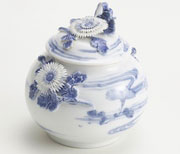
Mikawachi ware (called Mikawachi yaki in Japanese) is a form of porcelain produced around the city of Sasebo, in Nagasaki prefecture. Mikawachi ware has long been regarded as a high-class item due to its simple yet eyecatching blue dye on white po…
View more
-
Tosa traditional Japanese paper Tosa washi
- Traditional Japanese paper
- Kochi
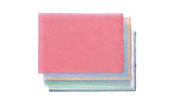
Tosa washi is a kind of traditional Japanese paper made in Kochi prefecture, both in the city of Tosa and around the town of Ino. In the past, it was used to make a holder for wallets and medicine or paper lanterns. Now it has a wide range of u…
View more
-
Echizen lacquerware Echizen shikki
- Lacquerware
- Fukui

Echizen lacquerware (called Echizen shikki in Japanese) is produced in the area around the city of Sabae in Fukui prefecture. Lacquer is at the center of life in the Echizen district of Sabae, which is known as the city of manufacturing. The notab…
View more
-
Echizen ware Echizen yaki
- Ceramic
- Fukui

Echizen ware (called Echizen yaki in Japanese) is a type of pottery produced in the town of Echizen, Fukui prefecture. This traditional handicraft comes from one of the Six Ancient Kilns of Japan which along with Bizen, Tamba, Tokoname, Seto, and …
View more
-
Tendo Japanese chess pieces Tendo shogi koma
- Other crafts
- Yamagata
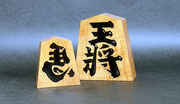
Tendo Japanese chess pieces (called Tendo shogi koma in Japanese) are made in the cities of Tendo, Yamagata, and Murayama in Yamagata prefecture. Production is thought to have begun in Tendo back during the Edo period (1603-1868) and now the city …
View more
-
Yamagata cast iron Yamagata imono
- Metal works
- Yamagata
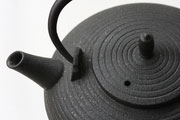
Yamagata cast iron (called Yamagata imono in Japanese) is produced in the city of Yamagata, Yamagata prefecture. At first, metal fittings, Buddhist statues, and daily use items were made. Then, as skills and techniques were developed, iron kettles…
View more
-
Wakasa lacquerware Wakasa nuri
- Lacquerware
- Fukui

Wakasa lacquerware (called Wakasa-nuri in Japanese) is produced in the area around the city of Obama, Fukui prefecture. It is said to have originated in the early Edo period (1603-1868) when a craftsman serving the Obama domain (now the city of Ob…
View more
-
Suzuka inksticks Suzuka sumi
- Writing tools
- Mie
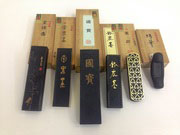
Suzuka inksticks (called Suzuka sumi in Japanese) are made in the city of Suzuka, Mie prefecture. This is the only inkstick craft registered as a Traditional Japanese Craft. Just one company, Shinseido, continues to produce Suzuka inksticks. This …
View more
-
Yokkaichi-banko ware Yokkaichi banko yaki
- Ceramic
- Mie
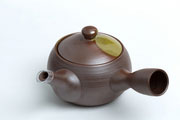
Yokkaichi banko ware (called Yokkaichi banko yaki in Japanese) is a form of ceramic ware produced in the city of Yokkaichi, Mie prefecture. For a long time, items for everyday use like teacups and plates, as well as pieces of art like vases have b…
View more
-
Echizen cutlery Echizen uchihamono
- Metal works
- Fukui

Echizen cutlery (called Echizen uchihamono in Japanese) is produced around the city of Echizen, Fukui prefecture. A double layering technique is used for knives and a rotated steel joining technique for sickles. Double layering is a forging method…
View more
-
Oitama tsumugi silk Oitama tsumugi
- Woven textiles
- Yamagata
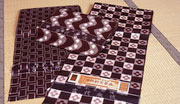
Oitama tsumugi is a silk fabric produced in the Yonezawa, Hakutaka and Nagai regions of Oitama in southern Yamagata prefecture. The area was well-known for producing and exporting ramie, a tall plant of the nettle family that has been used to make…
View more
-
Tosa cutlery Tosa uchihamono
- Metal works
- Kochi
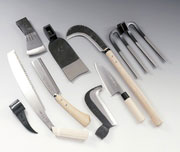
Tosa cutlery (called Tosa uchihamono in Japanese) are hammer-forged blades produced in the eastern to central part of Kochi prefecture, including the town of Ino and the cities of Kami, Nankoku, Tosa, and Susaki. Kochi prefecture was once a provin…
View more
-
Iga braided cords Iga kumihimo
- Other textiles
- Mie
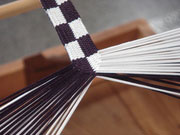
Iga Braided Cords, called Iga Kumihimo in Japanese, are made in Mie prefecture. Mainly silk threads are used, often in combination with gold and silver threads. This craft is known for rich silk threads, being dyed in a vibrant range of colors, an…
View more
-
Nibutani carved wooden tray Nibutani ita
- Wood, bamboo crafts
- Hokkaido
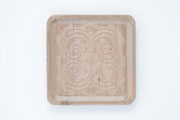
Nibutani Carved Wooden Trays (called Nibutani ita in Japanese) are produced in Biratori, Hokkaido. The origin of the town name, is an Ainu language word for cliff, pirauturu. This craft is known for its patterns like a spiral pattern called moreun…
View more
-
Ise paper stencil printing Ise katagami
- Industrial art materials and tools
- Mie
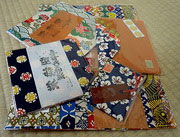
The Japanese name of Ise Paper Stencil Printing is Ise Katagami. Katagami means paper stencil. Today this craft is mostly produced in the city of Suzuka in Mie prefecture. They are an important part of textile dyeing. For many years, such stencils…
View more
-
Nibutani bark cloth Nibutani attoushi
- Woven textiles
- Hokkaido
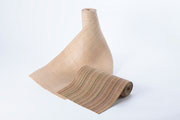
Nibutani Bark Cloth (called Nibutani-attushi in Japanese) is a bark fiber fabric produced in the region surrounding the the town of Biratori, Hokkaido. The term Nibutani originates from niputai which is an Ainu (indigenous people of north Japan) l…
View more
-
Uetsu tilia bark cloth Uetsu shinafu
- Woven textiles
- Yamagata
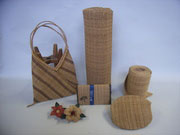
Uetsu Shinafu is a textile produced in the area of Sekikawa, Tsuruoka, Yamagata prefecture, and Sanpoku, Murakami, Niigata prefecture. The names of the neighboring prefectures of Yamagata (Uzen) and Niigata (Echigo) are combined and called Uetsu, …
View more
-
Echizen traditional chest Echizen tansu
- Wood, bamboo crafts
- Fukui
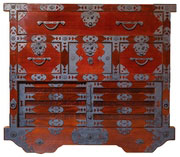
Echizen Tansu are lacquer coated chests of drawers made around Echizen City and Sabae City of Fukui Prefecture. They are mainly made of Japanese zelkova and paulownia, and decorated with iron fittings and lacquer. Japanese zelkova is a hard wood w…
View more
-
Wakasa agate craft Wakasa meno zaiku
- Semiprecious stone craftwork
- Fukui
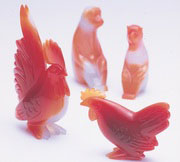
Wakasa Agate Craft (Wakasa Meno Zaiku in Japanese) is agate craftwork produced around the city of Obama, Fukui prefecture. Agate has been appreciated from olden times as one of the seven treasures that decorated the sublime Buddhist paradise ment…
View more
-
Yamagata Buddhist altar Yamagata butsudan
- Household Buddhist altars
- Yamagata
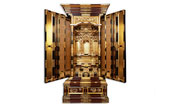
Yamagata Butsudan are Buddhist altars mainly made in Yamagata City, Tendo City, Obanazawa City, and Sakata City, Yamagata Prefecture, which distinguishes the prefecture as the largest center of altar production in the Tohoku region. Kichibei HOSHI…
View more
-
Makabe stone lanterns Makabe ishidoro
- Stonework
- Ibaraki
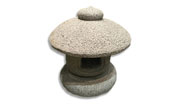
Makabe Ishitoro is the Japanese name for Makabe stone lanterns produced around the town of Makabe in the Ibaraki Prefecture. Production of this traditional craftwork started during the Kamakura period (1185-1333). The stone industry in the Makabe …
View more
-
Nagasaki tortoise shell crafts Nagasaki bekkou
- Other crafts
- Nagasaki
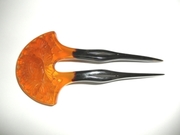
Nagasaki tortoise shell crafts called Nagasaki Bekko in Japanese, are mostly produced in the city of Nagasaki or Isahaya in the Nagasaki prefecture. The shells used come from a type of sea turtle living around the Equator called Hawksbill turtle. …
View more
- 1

































































































































































































































































































